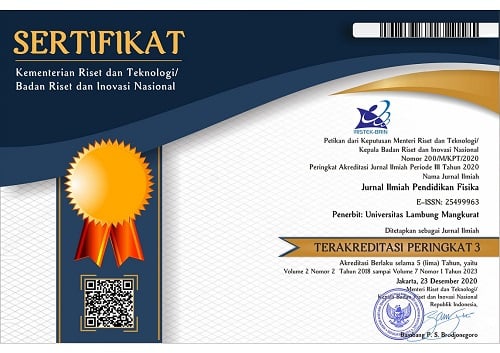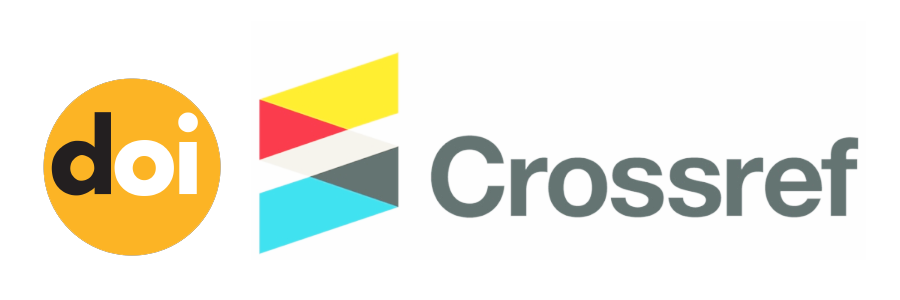Usability of Screencast in 1st Basic Physics Lectures During the Covid-19 Pandemic: Student’s Perception Analysis
Abstract
The enactment of Work from Home (WFH) during the Covid-19 pandemic has affected educational activities. Conventional offline learning must be held online so that effective online learning media is needed. The screencast is an online learning media that believed can provide easy access to students in conducting an online lecture. The screencast is a digital video recording on the computer screen and usually includes audio narration. This study aimed to analyze students' perception on screencast use in 1st Basic Physics lectures during the Covid-19 pandemic. This research involved 76 physics education students in one of the higher education institutions in Tasikmalaya. They consist of 9 males and 67 females in the age range (18-21 years). This research is a descriptive study, with data collection techniques using a Likert scale questionnaire. Analysis of students' perceptions of screencast aspects (content, construct, language, and graphic) are good, with a value of 79. Then, analysis of screencast implications on changes in students' knowledge and skills are a good category with a value of 78. The analysis of students' perceptions found a positive response using screencast in 1st Basic Physics lecture. The screencast can be effective online learning media to enhance student's knowledge and skills
Keywords
Full Text:
PDFReferences
Abdul Razak, M. R., & Mohamad Ali, A. Z. (2016). Instructional screencast: A research conceptual framework. Turkish Online Journal of Distance Education, 17(2), 74–87. https://doi.org/10.17718/tojde.21316
Alvarado, S., Kanter-Braem, B., Manz, K., Masciopinto, P., McKenna, E., Nelson, D., Williams, C., & Korek, K. (2011). Sensation and perception: a unit lesson plan for high school psychology teachers. National Standards for High School Psychology Curricula, 1–46.
Ceroni, M. R., Carpigiani, B., Castanheira, M. P., & Silva, A. A. da. (2016). The Perception of Teachers about Students’ Potentialities and Difficulties. Procedia - Social and Behavioral Sciences, 217, 958–966. https://doi.org/10.1016/j.sbspro.2016.02.070
Evans, D. J. R. (2011). Using embryology screencasts: A useful addition to the student learning experience? Anatomical Sciences Education, 4(2), 57–63. https://doi.org/10.1002/ase.209
Fook, C. Y., Sidhu, G. K., Shah, N. K. M., & Aziz, N. A. (2011). Pre-service teachers’ training in information communication and technology for the ESL classrooms in Malaysia. Turkish Online Journal of Distance Education, 12(3), 97–108. https://doi.org/10.17718/tojde.56165
Fraser, A., & Maclaren, P. (2012). Patterns of instruction: Using screencasts in the teaching of textile design. Futures Challenges, Sustainable Futures, 16, 331–332. https://doi.org/https://doi.org/10.1007/s10798-005-4327-y.
Ghilay, Y., & Ghilay, R. (2015). Computer courses in higher-education: improving learning by screencast technology. I-Manager’s Journal of Educational Technology, 11(4), 15–26. https://doi.org/10.26634/jet.11.4.3148
Hidayat, H., & Handayani, P. G. (2018). Self regulated learning (study for students regular and training). Jurnal Penelitian Bimbingan Dan Konseling, 3(1), 50–59. https://doi.org/10.30870/jpbk.v3i1.3196
Mullamphy, D., Higgins, P., Belward, S., & Ward, L. M. (2010). To screencast or not to screencast. ANZIAM Journal, 51, 446. https://doi.org/10.21914/anziamj.v51i0.2657
Nguyen, T. (2015). The effectiveness of online learning: Beyond no significant difference and future horizons. MERLOT Journal of Online Learning and Teaching, 11(2), 309–319.
Ozsvald, I. (2010). The screencasting handbook: Teaching you to become a better broadcaster (1st ed.). https://thescreencastinghandbook.com/
Ramli, R., Suriani, A., Yunus, M., Mohid, S. Z., Abas, H., & Baharudin, H. (2017). A review on the innovative use of screencast technique for learning 3D animation software. Fstm.Kuis.Edu.My, September, 42–48. http://fstm.kuis.edu.my/icits/2017/eproceeding/IC-ITS2017 IT12 pp42-48 Roslinda.pdf
Rizal, R., Rusdiana, D., Setiawan, W., & Siahaan, P. (2020). Students perception of learning management system supported smartphone: Satisfaction analysis in online physics learning. Jurnal Pendidikan IPA Indonesia, 9(4), 600–610. https://doi.org/10.15294/jpii.v9i4.25363
Rizal, R., Setiawan, W., & Rusdiana, D. (2019). Digital literacy of preservice science teacher. Journal of Physics: Conference Series, 1157(2). https://doi.org/10.1088/1742-6596/1157/2/022058
Rizal, Rahmat, Rusdiana, D., Setiawan, W., & Siahaan, P. (2020). Digital literacy test: development of multiple choice test for preservice physics teachers. International Journal of Advanced Science and Technology, 29(03), 7085–7095.
Rizal, Rahmat, Susanti, E., Sulistyaningsih, & Budiman, D. M. (2020). Desain evaluasi program pelatihan guru fisika profesional. Diffraction, 2(1), 30–37. https://doi.org/10.37058/diffraction.v2i1.1695
Soto, M., & Ambrose, R. (2016). Screencasts: Formative assessment for mathematical thinking. Technology, Knowledge and Learning, 21(2), 277–283. https://doi.org/10.1007/s10758-015-9272-6
Sugar, W., Brown, A., & Luterbach, K. (2010). Examining the anatomy of a screencast: Uncovering common elements and instructional strategies. International Review of Research in Open and Distance Learning, 11(3), 1–20. https://doi.org/10.19173/irrodl.v11i3.851
Twabu, K. Y. (2018). Screencast as a technology enhanced teaching tool at an open distance learning university in south africa [University of South Africa]. In University of South Africa. http://hdl.handle.net/10500/24937
DOI: https://doi.org/10.20527/jipf.v5i3.3903
Refbacks
- There are currently no refbacks.
Indexed by: Jurnal Ilmiah Pendidikan Fisika is licensed under a creative commons attribution-share alike 4.0 international license
Statistics Counter |
















